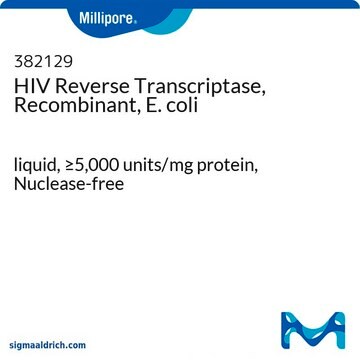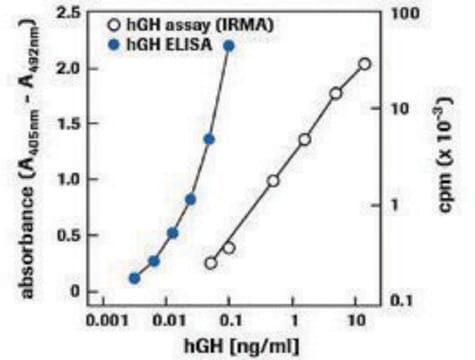11468120910
Roche
Reverse Transcriptase Assay, colorimetric
suitable for enzyme immunoassay, kit of 1 (14 components), sufficient for ≤200 tests
Synonym(s):
RT-PCR
Sign Into View Organizational & Contract Pricing
All Photos(2)
About This Item
UNSPSC Code:
41105333
Recommended Products
usage
sufficient for ≤200 tests
Quality Level
packaging
kit of 1 (14 components)
manufacturer/tradename
Roche
technique(s)
enzyme immunoassay: suitable
storage temp.
−20°C
Related Categories
General description
Colorimetric enzyme immunoassay for the quantitative determination of retroviral reverse transcriptase activity by incorporation of digoxigenin- and biotin-labeled dUTP into DNA.
Application
The Reverse Transcriptase Assay is designed for the quantitative determination of RT activity in cell culture and other biological samples. The assay is used to determine the propagation of retroviruses in retrovirus-infected mammalian cells in culture. The assay is also used for in vitro screening for RT inhibitors.
Packaging
1 kit containing 14 components.
Specifications
Assays for reverse transcriptase (RT) activity have been broadly applied for testing retroviral propagation in vitro. RT is required for early proviral DNA synthesis, and is thus a prime target for anti-retroviral therapy, for example, in the case of acquired immunodeficiency syndrome (AIDS). Reverse transcriptase generally uses RNA, which is complexed with various primers, as a template for DNA synthesis. Classically, for the detection or quantification of RT activity, the amount of incorporated radioactively labeled nucleotides is measured.
Assay time: Approximately 4 hours (for an enzyme reaction of 1 hour), approximately 18 hours (for an enzyme reaction of 15 hours).
Sample material: Cell culture supernatant and other biological samples, RT inhibitors.
Sensitivity: The Reverse Transcriptase Assay detects 20pg HIV-1 reverse transcriptase in a 1-hour reaction. One pg can be detected in an overnight reaction.
Assay time: Approximately 4 hours (for an enzyme reaction of 1 hour), approximately 18 hours (for an enzyme reaction of 15 hours).
Sample material: Cell culture supernatant and other biological samples, RT inhibitors.
Sensitivity: The Reverse Transcriptase Assay detects 20pg HIV-1 reverse transcriptase in a 1-hour reaction. One pg can be detected in an overnight reaction.
The assay detects the activity of natural or recombinant retroviral reverse transcriptase, including that of HIV-1, HIV-2, SIV-1, AMV, and M-MulV.
Principle
The Reverse Transcriptase Assay, colorimetric, takes advantage of the ability of reverse transcriptase to synthesize DNA using the hybrid poly (A) x oligo (dT)15 as a template and primer. It avoids the use of [3H]- or [32P]-labeled nucleotides that are employed in standard RT assays. In place of radiolabeled nucleotides, digoxigenin- and biotin-labeled nucleotides in an optimized ratio are incorporated into the same DNA molecule by the RT activity. A template/primer hybrid is supplied, but the flexibility of the assay allows the use of a template of choice (e.g., a viral template). The detection and quantification of the synthesized DNA as a parameter for RT activity follows a sandwich ELISA protocol: biotin-labeled DNA binds to the surface of streptavidin-coated microplate modules. In the next step, an antibody to digoxigenin, conjugated to peroxidase (anti-DIG- POD), is added and bound to the digoxigenin-labeled nucleotides (Licensed by Institute Pasteur). In the final step, the peroxidase substrate ABTS is added. The peroxidase enzyme catalyzes the cleavage of the substrate to produce a colored reaction product. The absorbance of the samples is determined using a microplate (ELISA) reader, and is directly correlated to the level of RT activity in the sample.
Other Notes
For life science research only. Not for use in diagnostic procedures.
Kit Components Only
Product No.
Description
- HIV-1 Reverse Transcriptase
- Incubation Buffer
- Nucleotides
- Template/Primer Hybrid
- Lysis Buffer
- Anti-Digoxigenin-POD antibody
- Washing Buffer Concentrate 10x concentrated
- Conjugate Dilution Buffer
- Substrate Buffer
- ABTS Substrate
- Substrate Enhancer
- Microplate Modules, precoated with streptavidin
- One Strip Frame (for 8-well microplate modules)
- Cover Foils for Microplates
See All (14)
Signal Word
Danger
Hazard Statements
Precautionary Statements
Hazard Classifications
Aquatic Chronic 3 - Eye Dam. 1 - Skin Sens. 1
Storage Class Code
12 - Non Combustible Liquids
WGK
WGK 2
Flash Point(F)
does not flashNot applicable
Flash Point(C)
does not flashNot applicable
Certificates of Analysis (COA)
Search for Certificates of Analysis (COA) by entering the products Lot/Batch Number. Lot and Batch Numbers can be found on a product’s label following the words ‘Lot’ or ‘Batch’.
Already Own This Product?
Find documentation for the products that you have recently purchased in the Document Library.
Customers Also Viewed
Setsuko Shioda et al.
Royal Society open science, 5(5), 172472-172472 (2018-06-13)
Human cell lines have been used in a variety of research fields as an in vitro model. These cells are all derived from human tissue samples, thus there is a possibility of virus infection. Virus tests are routinely performed in
K J Norberg et al.
BMC cancer, 20(1), 475-475 (2020-05-29)
Pancreatic ductal adenocarcinoma is a devastating disease with poor outcome, generally characterized by an excessive stroma component. The purpose of this study was to develop a simple and reproducible in vitro 3D-assay employing the main constituents of pancreatic ductal adenocarcinoma
Stefano Boi et al.
Journal of virology, 88(13), 7659-7662 (2014-04-11)
APOBEC3 proteins are restriction factors that induce G→A hypermutation in retroviruses during replication as a result of cytidine deamination of minus-strand DNA transcripts. However, the mechanism of APOBEC inhibition of murine leukemia viruses (MuLVs) does not appear to be G→A
Elke Brötz et al.
The Journal of antibiotics, 64(3), 257-266 (2011-02-03)
Phenelfamycins G and H are new members of the family of elfamycin antibiotics with the basic structure of phenelfamycins E and F, respectively, which are also well known as ganefromycins α and β. Phenelfamycins G and H differ from phenelfamycins
Katarzyna Karwacz et al.
Journal of virology, 83(7), 3094-3103 (2009-01-30)
Lentiviral vectors (lentivectors) are effective for stimulation of cell-mediated and humoral immunity following subcutaneous and intramuscular immunization. However, lentivector genome integration carries a risk of perturbation of host gene expression. Here, we demonstrate that lentivectors with multiple mutations that prevent
Our team of scientists has experience in all areas of research including Life Science, Material Science, Chemical Synthesis, Chromatography, Analytical and many others.
Contact Technical Service













